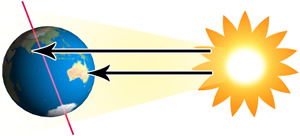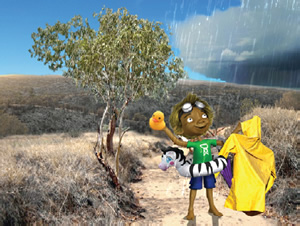In many parts of the world, the year is made up of four seasons: spring, summer, autumn and winter. Each season has its own weather patterns and they match to particular months of the year.
What causes the seasons?

Do you know why we have different seasons?
The Earth tilts on an angle as it orbits the sun. This means that during different parts of the year either the northern hemisphere (the top half of the world) or southern hemisphere (the bottom half of the world) will lean closer to the sun. The part leaning closer to the sun will have more light and heat (this will be the warmer months) and the part leaning away from the sun will have less light and heat (the cooler months).
In Australia, we are leaning closer to the sun in the summer months of December, January and February, but in other countries this is different. Countries that are in the northern hemisphere (such as America, Canada and England) have summer in June, July and August.
Spring

In Australia, it is spring in the months of September, October and November.
In spring, the temperatures start to rise and the days become longer.
Spring can have lots of different types of weather. It can be sunny and dry and then change to wet and rainy. In spring we usually have moderate temperatures which means it is not too hot and not too cold.
After the cold winter, the plants and trees start to blossom and flower in spring. Some animals that have been hidden away will come out and many have their babies in spring. In spring you will find that mangoes, avocadoes all sorts of melons are ready to eat.
Summer

Summer in Australia is in the months of December, January and February.
In summer it is hot and dry. It can even be very hot after the sun goes down at night. There is often not a lot of rain in summer.
There are lots of leaves on trees in summer and many plants produce fruit. The animals that were born in spring grow bigger in summer so they are stronger for the colder weather that comes in autumn and winter.
In summer people try to stay cool with activities like swimming and spending time in shady parks and gardens, and we can enjoy delicious stone fruits (like apricots, peaches and cherries) and pineapple.
Autumn

In Australia, it is autumn in the months of March, April and May. Did you know that in some places around the world autumn is called ‘fall’?
The weather gets cooler in autumn and the days get shorter. The leaves on many trees start to change colour and then fall to the ground. Have you ever walked down a street that was covered in orange, yellow and brown leaves? It’s fun!
Animals put on weight to prepare for the colder months when there may not be as much food to eat. Fruits, such as apples and pears, are ready to be picked and eaten.
Winter

After autumn comes winter in the months of June, July and August.
Winter is the coldest month and there is often lots of rains and windy weather. In some parts of Australia we even get snow. The days are short and the nights are longer in winter. A day is still 24 hours, but we have less hours of sunlight and more hours of darkness.
Many trees are bare (have no leaves) and some birds fly north to find warmer weather. Did you know that some Australian animals, such as the pygmy possum, some bats and some echidnas hibernate during winter? This means that they go to sleep for much of the colder months and wake up when the weather is warmer.
In winter, people may prefer indoor activities like playing games, reading or watching movies and we can enjoy eating oranges, mandarins and kiwifruit.
Far northern Australia

While most of Australia has four different seasons, the far northern part (right up the top of the country) really only has two seasons, the wet season and the dry season.
The wet season lasts from about December to March. The weather will be very hot and humid and there will be a lot of rain and thunder storms.
The dry season is between May and October. The temperature is lower and there is very little or no rain.
References
The following links will direct you to the homepage of the websites used as references for this topic.
- Kidcyber: www.kidcyber.com.au/seasons-in-australia
- Australia.gov.au: www.australia.gov.au




